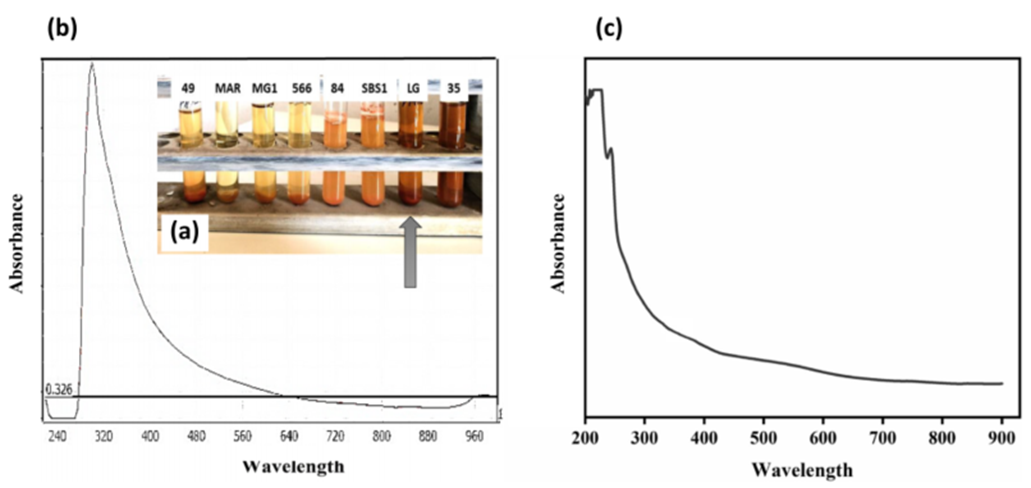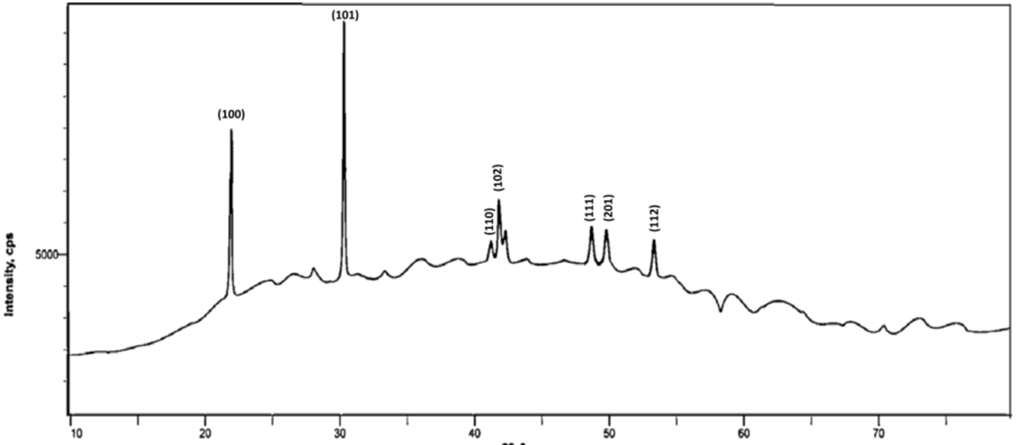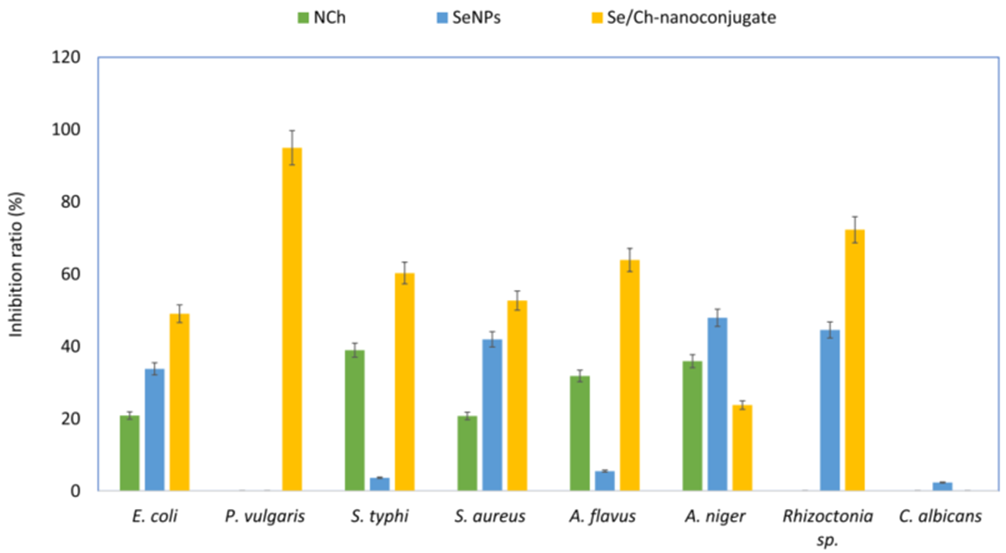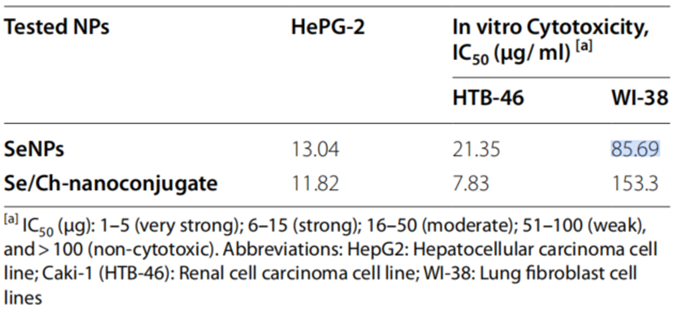Editor: Tiffany
New research demonstrates that selenium nanoparticles and their nanoconjugate with chitosan, synthesized from the marine actinomycete Streptomyces parvulus MAR4, exhibit significant antimicrobial and anticancer properties, presenting a potential solution to the rising threat of multidrug resistance and cancer treatment challenges.
Key Highlights
- Research Question:
Can biogenic selenium nanoparticles (SeNPs) and their nanoconjugate with chitosan function as effective antimicrobial and anticancer agents? - Research Difficulties:
The study tackles the pressing issue of multidrug-resistant pathogens and the limitations of existing cancer therapies, necessitating innovative solutions. - Key Findings:
The SeNPs displayed strong antimicrobial activity against various pathogens and significant cytotoxicity against cancer cell lines, particularly when conjugated with chitosan, enhancing their stability and efficacy. - Innovative Aspects:
This research utilizes a green synthesis approach to create nanoparticles using a marine actinomycete, highlighting a sustainable method for producing effective biomedical agents. - Importance of the Study:
The findings suggest that these biogenic nanoparticles could address critical gaps in current treatments for infections and cancer, providing safer and more effective therapeutic options.
Context of Multidrug Resistance and Cancer Treatment
Multidrug-resistant (MDR) pathogens and cancer represent two of the most pressing health challenges of the 21st century. MDR pathogens, which have developed resistance to multiple antibiotics, pose a significant threat to global health, leading to prolonged illnesses, higher healthcare costs, and increased mortality rates. Similarly, cancer remains a leading cause of death worldwide, with many tumors developing resistance to conventional chemotherapies, further complicating treatment efforts. Current therapeutic options, such as antibiotics for infections and chemotherapy for cancer, are increasingly limited by resistance mechanisms and adverse side effects. For instance, the misuse of antibiotics has accelerated the emergence of resistant bacterial strains, while chemotherapy often causes severe toxicity in patients, reducing its efficacy and patient compliance. These limitations underscore the urgent need for novel, effective, and safer therapeutic agents.
Research Aim & Objectives
The research aimed to address the critical need for new antimicrobial and anticancer agents by exploring the potential of biogenic selenium nanoparticles (SeNPs) and their conjugate with nano-chitosan (Se/Ch-nanoconjugate). The primary research questions revolved around whether these biosynthesized nanoparticles could effectively combat MDR pathogens and cancer cells while minimizing toxicity to normal cells. The main objectives were to biosynthesize SeNPs using marine actinomycetes, conjugate them with nano-chitosan, and evaluate their antimicrobial and anticancer properties. The study was conducted by Mervat G. Hassan and colleagues from the National Research Center in Egypt, Mansoura University, and Menoufia University. The research was published in BMC Microbiology on January 15, 2024.
Methodological Approach and Experimental Findings
Experimental Process Outline:
- Collection of marine sediment samples.
- Isolation of actinomycetes using selective agar media.
- Screening for selenium nanoparticles (SeNPs) production.
- Biosynthesis of SeNPs by selected actinomycete strain using sodium selenate.
- Characterization of biosynthesized SeNPs using UV-visible spectroscopy, X-ray diffraction (XRD), Fourier-transform infrared spectroscopy (FTIR), transmission electron microscopy (TEM), scanning electron microscopy (SEM), and energy dispersive X-ray (EDX).
- Preparation of nano-chitosan (NCh) through ionic gelation with tripolyphosphate (TPP).
- Formation of Se/Ch-nanoconjugate by mixing SeNPs with NCh.
- Evaluation of antimicrobial activity against various microbial pathogens.
- Assessment of enzyme activity inhibition in microbial pathogens.
- Testing cytotoxicity against cancer cell lines using the MTT assay.
Key Experiments
Experiment 1: Biosynthesis of Selenium Nanoparticles (SeNPs)
- Procedure:
- Inoculate the selected actinomycete strain (Streptomyces parvulus MAR4) in ISP2 media.
- Incubate at 30-32 °C for 7 days with shaking.
- Centrifuge to separate the supernatant from the biomass.
- Add sodium selenate (Na2SeO4) to the supernatant and incubate at 37 °C for 48 hours.
- Result:
- Observation of a color change from pale yellow to deep orange, indicating SeNPs synthesis.
- Finding:
- UV-visible spectroscopy confirmed the presence of SeNPs, showing a strong absorption peak at 300 nm, which is characteristic of selenium nanoparticles.

Figure 1. (a) The visual appearance of eight actinomycetes supernatants containing Na2SeO4 after 48h of incubation. UV–Visible absorption spectra of (b) biosynthesized SeNPs, and (c) supernatant (LG).
Experiment 2: Characterization of SeNPs
- Procedure:
- Analyze the synthesized SeNPs using X-ray diffraction (XRD) to assess crystallinity.
- Conduct Fourier-transform infrared spectroscopy (FTIR) to identify functional groups present.
- Utilize transmission electron microscopy (TEM) to evaluate particle morphology and size.
- Result:
- XRD analysis revealed distinct diffraction peaks corresponding to crystalline selenium.
- FTIR spectra indicated the presence of functional groups associated with the biomolecules involved in the reduction of selenium.
- TEM images showed spherical SeNPs with an average diameter of approximately 94.2 nm.
- Finding:
- The characterization confirmed successful biosynthesis and stability of SeNPs, which possess desirable properties for biomedical applications.

Figure 2. XRD difractogram of SeNPs extracellularly synthesized by Streptomyces parvulus MAR4.
Experiment 3: Antimicrobial Activity Assessment
- Procedure:
- Prepare a 96-well microtiter plate with varying concentrations of SeNPs, NCh, and Se/Ch-nanoconjugate.
- Inoculate the wells with different microbial pathogens, including E. coli, S. aureus, and A. flavus.
- Incubate overnight at 37 °C and measure absorbance to evaluate microbial growth.
- Result:
- The Se/Ch-nanoconjugate demonstrated superior antimicrobial activity against the tested pathogens, particularly against S. typhi and P. vulgaris.
- Finding:
- The data indicated that the Se/Ch-nanoconjugate is a highly effective antimicrobial agent, outperforming both SeNPs and NCh alone, suggesting its potential use in treating infections caused by multidrug-resistant pathogens.

Figure 3. Antimicrobial activity of synthesized nanoparticles against wide range of microbial pathogens.
Experiment 4: Cytotoxicity Testing
- Procedure:
- Culture HepG2 (hepatocellular carcinoma), Caki-1 (renal cell carcinoma), and WI-38 (normal lung fibroblast) cell lines in a 96-well plate.
- Treat the cells with various concentrations of SeNPs and Se/Ch-nanoconjugate.
- After 24 hours, perform the MTT assay to assess cell viability.
- Result:
- SeNPs exhibited significant cytotoxicity against HepG2 (IC50 = 13.04 μg/ml) and Caki-1 (IC50 = 21.35 μg/ml), while showing low cytotoxicity against WI-38 (IC50 = 85.69 μg/ml).
- Finding:
- The Se/Ch-nanoconjugate displayed enhanced cytotoxicity with lower IC50 values (11.82 μg/ml for HepG2 and 7.83 μg/ml for Caki-1), indicating its potential as an effective anticancer agent with minimal toxicity to normal cells.

Table 1. Cytotoxic efects of biosynthesized SeNPs by Streptomyces parvulus MAR4 supernatant and Se/Ch-nanoconjugate against HePG-2 and Caki-1 (HTB-46) cell lines.
Implications and Future Directions of the Research
This study presents a significant advancement in the development of biogenic nanoparticles for biomedical applications. The key innovation lies in the biosynthesis of selenium nanoparticles using Streptomyces parvulus MAR4 and their conjugation with nano-chitosan, resulting in a nanoconjugate with enhanced antimicrobial and anticancer properties. The Se/Ch-nanoconjugate demonstrated superior efficacy against a broad spectrum of MDR pathogens and cancer cell lines, while exhibiting minimal toxicity to normal cells. These findings suggest that the nanoconjugate could serve as a versatile therapeutic agent, addressing the dual challenges of antibiotic resistance and cancer treatment limitations. The research underscores the potential of biogenic nanoparticles as a safer, more effective alternative to conventional therapies, paving the way for future studies to explore their clinical applications.
Reference:
Hassan, Mervat G., et al. “Biogenic selenium nanoparticles and selenium/chitosan-Nanoconjugate biosynthesized by Streptomyces parvulus MAR4 with antimicrobial and anticancer potential.” BMC microbiology 24.1 (2024): 21.
